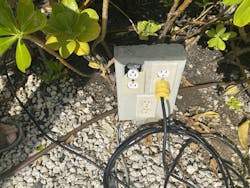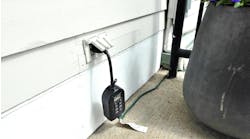How well do you know the Code? Think you can spot violations the original installer either ignored or couldn’t identify? Here's your chance to moonlight as an electrical inspector and second-guess someone else's work from the safety of your living room or office. Can you identify the specific Code violation(s) in this photo? Note: Submitted comments must include specific references from the 2023 NEC.
Hint: The weather forecast calls for rain.
Tell Them What They've Won…
Using the 2023 NEC, correctly identify the Code violation(s) in this month's photo — in 200 words or less — and you could win a $25 Amazon gift card. E-mail your response, including your name and mailing address, to [email protected], and Russ will select one winner (excluding manufacturers and prior winners) at random from the correct submissions. Note that submissions without an address will not be eligible to win.
February Winner
This month’s winner is Robert Barnett with Tri-County Electric LLC of Brookville, Ohio. He knew that knockout rings cannot be used to establish the electrical continuity between the metal raceways and the metal enclosure of this disconnect when the circuit is operating over 250V to ground.
This 3-phase, 480V circuit is operating at 277V to ground. For installations like this, Sec. 250.97 requires the continuity between the metal raceways and metal cabinet to be “ensured by one or more of the methods specified for services in Sec. 250.92(B) except for (B)(1).”
Section 250.92(B)(4) specifies the use of bonding locknuts, bushings, or bonding bushings with bonding jumpers to bond around the remaining rings. Bonding bushings with bonding jumpers would be great here. Using only standard locknuts for bonding and grounding these raceways is not permitted.






